Double Bay Tree Trail
Explore the foreshores and suburban streets of Double Bay to discover our magnificent trees. An online map is available for everyone to follow.
The trail is about 2 kilometres long, starting at Redleaf Beach and Blackburn Gardens then winding through Double Bay and finally heading up along Ocean Avenue to Edgecliff. If you want to avoid walking up the Ocean Avenue hill, walk the trail in reverse.
Most of the trees along the trail now have signs.
If you walk the trail please share your feedback by emailing us.
About the trees
Our Tree Trail starts at the entrance to Redleaf near Blackburn Gardens. The first tree is at the entrance gates. Then you can head down towards Redleaf Beach and Cafe, across the beach then wind up through Blackburn gardens.
1. Norfolk Island Pine

This tree and several others along the Double Bay Tree Trail are listed in our Significant Tree Register that recognises and protects trees with unique historic, social or botanical values.
What's special about this tree?
Norfolk Island pines were originally found only on Norfolk Island and were introduced to Sydney in the early years of European settlement.
These trees were made popular by the distinctive triangular appearance and tendency to grow straight, even when growing in coastal areas with high winds and salty conditions.
This trees can be seen in many coastal stretches of Sydney.
- Species Name: Araucaria Heterophylla
- Height: 27 m
- Spread: 12 m
- Age: 130+ years
2. Hoop Pine

Hoop Pines are rainforest trees naturally found in coastal regions of northern NSW and Queensland.
What's special about this tree?
These trees can live up to 450 years and have a straight, rough-barked trunk with circular "hoop" markings that give it the common name. This tree is part of the same botanical family as the Bunya Pine and Norfolk Island Pine, also seen here at Redleaf.
Birds such as the local magpies can be drawn to this tree for nesting as its prickly foliage offers protection.
- Species Name: Araucaria cunninghamii
- Height: 26 m
- Spread: 14 m
- Age: 130+ years
This tree does not have a sign. It can be viewed from the terrace area outside Council Chambers, looking towards the beach.
3. Chir Pine

What's special about this tree?
This Chir Pine is native to the Himalayas. It has distinct bark that is dark brown with deep grooves and its cones produce edible seeds. These trees can also be tapped for their resin.
- Species Name: Pinus roxburghii
- Height: 15 m
- Spread: 12 m
- Age: 130+ years
4. Queensland Kauri Pine

What's special about this tree?
This giant of a tree is listed on the National Register of Big Trees as one of the largest known living trees of this species.
Trees in the Kauri family have been known in Australia since the time of the dinosaurs and individual trees can live for hundreds of years. These trees were heavily logged in Queensland.
- Species Name: Agathis robusta
- Height: 31 m
- Spread: 22 m
- Age: 130+ years
5. Chinese Weeping Cypress
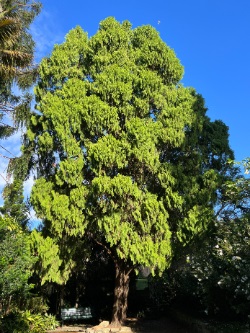
What's special about this tree?
This tree is admired for the beautiful weeping form of its branches.
Did you know most pines have male and female cones? Seed bearing cones are female, while the pollen filled cones are male.
This tree is native to the forests of south-western and central China.
- Species Name: Cupressus funebris
- Height: 16 m
- Age: 100+ years
6. Moreton Bay Fig

What's special about this tree?
The flowers of a fig tree are found inside the fruit, so you won't see these trees blossom. Did you know figs are only pollinated by fig wasps and these wasps can only reproduce inside the fig flowers?
- Species Name: Ficus macrophylla
- Height: 24 m
- Spread: 30 m
- Age: 130+ years
7. Bunya Pine
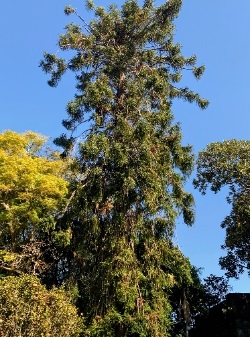
What's special about this tree?
Bunya Pines are native to south-east Queensland and were once abundant in rainforest areas.
The cones of this tree can be around 20-30 cm in diameter and weigh up to 5 kg. Cockatoos and other large birds can open the cones to eat the kernels.
Aboriginal people traditionally travelled long distances to collect and eat the tasty and highly nutritious seeds that were often roasted in a fire.
- Species Name: Araucaria bidwillii
- Height: 20 m
- Spread: 7 m
- Age: 120+ years
8. Leopard Tree
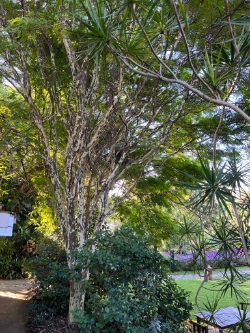
What's special about this tree?
Look at the bark of this tree to see why it’s named after a wild animal. The different colours form as the tree sheds its bark in patches.
In Brazil musical instruments including guitars are produced from the timber of this tree.
This tree is native to Brazil and Bolivia.
- Species Name: Libidibia ferrea
- Height: 12 m
- Age: 25+ years
9. Moreton Bay Fig

What's special about this tree?
This Moreton Bay Fig shows a wonderful example of buttress roots visible from the street.
This tree does not have a sign. It is a prominent feature when walking along the footpath of Williams street.
- Species Name: Ficus macrophylla
- Height: 25 m
- Spread: 30 m
- Age: 130+ years
10. Cluster of Native Trees

What's special about these trees?
This cluster of native trees provide cooling shade for the Steyne Park children's playground and dense habitat for local wildlife.
- River She-oaks (Casuarina cunninghamiana) produce a wonderful whistling sound when wind blows through the branches.
- Coastal Banksia (Banksia integrifolia) can attract nectar-feeding birds such as the New Holland Honeyeater.
- Tuckeroo (Cupaniopsis anacardioides) is a good shade tree with green-yellow flowers in spring and orange-yellow seed pods in summer.
- Cottonwood (Hibiscus tiliaceus) is a native hibiscus with prominent flowers often growing on beaches close to the water.
11. Port Jackson Fig
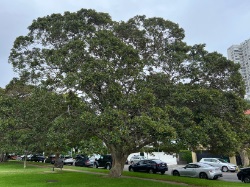
What's special about this tree?
The fruits of this fig are yellow and ripen to a reddish purple colour at the end of summer. These figs are favourites for many species of birds including parrots and pigeons.
Look closely at the underside of the leaves to see the velvety texture and rust colour.
- Species Name: Ficus rubiginosa
- Height: 14 m
- Age: 130+ years
12. Turpentine

What's special about this tree?
Turpentines are native to the rainforests and moist forests of Sydney and can be found in eastern Queensland and New South Wales. Its deeply grooved fibrous bark and the unique shape of its fruit help with identification.
Their dense clusters of white flowers attract insects, birds and other nectar eating animals.
They have timber that resists termites and is very durable in salt water. It can be used for building wharves, railway sleepers, telegraph poles and hard wearing flooring.
- Species Name: Syncarpia glomulifera
- Height: 17 m
13. Bottle Tree

What's special about this tree?
This Bottle Tree is nestled in the corner of Double Bay Public School grounds is named due to the unusual shape of its trunk.
Bottle Trees are one of the few Australian trees that lose their leaves. In their native area of central Queensland the trees usually lose their leaves between September and December.
They produce creamy-yellow flowers with red markings.
- Species Name: Brachychiton rupestris
- Height: 3 m
- Spread: 4 m
14. Black Booyong

What's special about this tree?
The Black Booyong is one of the largest buttressed trees found in the sub-tropical rainforests of eastern Australia. It has a deep green canopy with dark grey bark.
One of the most distinctive features of this tree are the large deep green leaves that radiate out from central stems like a palm.
It is an excellent shade tree and produces white bell shaped flowers in summer.
- Species Name: Argyrodendron actinophyllum
- Height: 15 m
- Spread: 15 m
15. Lemon-scented Gum
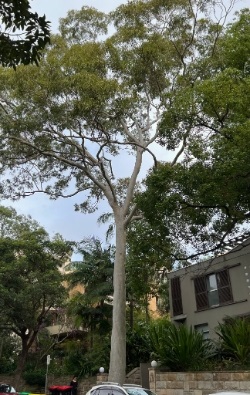
What's special about this tree?
This tall tree is admired for its creamy-white, smooth, straight trunk. Its elegant form has led to it being described as one of Australia’s most beautiful trees.
It has many commercial uses. Due to its straight growth it is used for beams, bridges and poles. Its flowers are important for honey production. Its volatile oil is an important commodity for cosmetics, medicines, and insect repellents.
If you find some leaves dropped on the footpath near this tree try crushing them to smell the fresh lemon scent.
Lemon-scented gums are native to the open forests and rainforests of northern Queensland.
- Species Name: Corymbia citriodora
- Height: 17 m
16. Queensland Lacebark
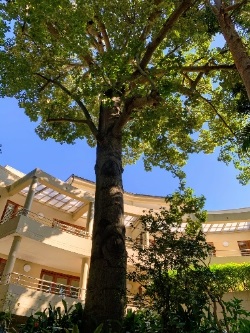
What's special about this tree?
This tree is found in drier rainforest areas of eastern Australia but it is not native to Sydney.
In early summer the Queensland Lacebark drops its leaves while it produces a beautiful display of bell-shaped, deep pink flowers. The flowers are very spectacular and are followed by seed capsules which contain many large seeds. As the flowers fade the leaves return.
- Species Name: Brachychiton discolor
- Height: 15 m
- Spread: 18 m
- Age: 120+ years
17. Candlenut Tree

What's special about this tree?
The Candlenut tree is a tropical rainforest species native to northern Australia and parts of Asia.
Most parts of these tree have been used by traditional groups of the South Pacific including to make oil, as timber and fibres for weaving.
The nuts can be burned like a candle, lasting 15 to 20 minutes each. Caution: the nuts from this tree can be toxic if eaten raw.
- Species Name: Aleurites moluccanus
- Height: 15 m
- Spread: 18 m
18. Moreton Bay Fig

What's special about this tree?
This majestic Moreton Bay Fig is a heritage listed tree in the grounds of Ascham School. It is a prominent local feature that can be seen from the corner of Ocean Street and New South Head Road. Please view this tree from the road.
- Species Name: Ficus macrophylla
- Height: 25 m
- Spread: 30 m
- Age: 120+ years
Explore our trails and walks in other areas.